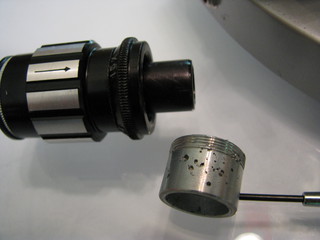New Tool/Project/Thing!
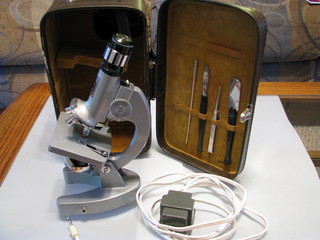
The electrical socket (first picture, on the base, near the connector) appears to be in good working condition. I was able to measure 3V AC at interior points. I was disappointed to discover the transformer (the gray brick in the first picture) is only a step-down. It drops the wall-current from 110V to 3V, but it doesn't convert it from AC to DC.
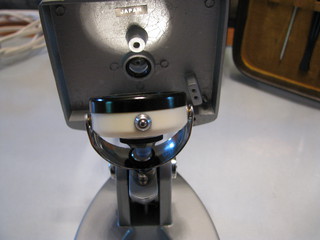
The illuminator is, in my ignorant opinion, pretty neat. One surface is a mirror. The other holds a blue-coated "classic" flashlight bulb. The metal ball-bearing-looking thing on the side of the illuminator is a contact-switch. When the bulb-side is uppermost, the ball's held against a small plate built into the base. That completes the circuit and energizes the lamp.
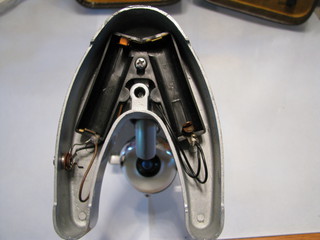 This is meant to be a portable device. In addition to wall-current, the lamp will run off of 2 AA batteries. Space for the batteries is in the base. I checked these, and the electrical connections appear to be functional here, as well. Which is good, because here's where the complications begin . . .
This is meant to be a portable device. In addition to wall-current, the lamp will run off of 2 AA batteries. Space for the batteries is in the base. I checked these, and the electrical connections appear to be functional here, as well. Which is good, because here's where the complications begin . . .

While visiting Nicole, we went to the Goodwill Store (great place to get a printer, if you need one). This was in the locked "really cool stuff" display, along with a bunch of games, a couple of RockBand/Guitar Hero controllers, a Wii Fit balance board, and a load of jewelry. The mirror worked, I could see through it, the knobs turned easily, and it was $15. How could I go wrong? So Nicole indulged me.

As you can see (click), this is a JASON Model No. 712 Deluxe 900x Zoom. Monocular (single eyepiece) with a 3-objective turret and both a reflector & bulb illuminator. i.e., a basic student microscope from the 60s. It's made of non-ferrous metal, not plastic, and chrome where anti-corrosion plating makes sense.
The kit is leather-over-wood, with flocking on the inside. Some of the tools are missing. The spatula, tweezers, scalpel, and some metal pipe-thingy are present. There are no slides, prepared or otherwise.

As you can see (click), this is a JASON Model No. 712 Deluxe 900x Zoom. Monocular (single eyepiece) with a 3-objective turret and both a reflector & bulb illuminator. i.e., a basic student microscope from the 60s. It's made of non-ferrous metal, not plastic, and chrome where anti-corrosion plating makes sense.
The kit is leather-over-wood, with flocking on the inside. Some of the tools are missing. The spatula, tweezers, scalpel, and some metal pipe-thingy are present. There are no slides, prepared or otherwise.
The electrical socket (first picture, on the base, near the connector) appears to be in good working condition. I was able to measure 3V AC at interior points. I was disappointed to discover the transformer (the gray brick in the first picture) is only a step-down. It drops the wall-current from 110V to 3V, but it doesn't convert it from AC to DC.

The illuminator is, in my ignorant opinion, pretty neat. One surface is a mirror. The other holds a blue-coated "classic" flashlight bulb. The metal ball-bearing-looking thing on the side of the illuminator is a contact-switch. When the bulb-side is uppermost, the ball's held against a small plate built into the base. That completes the circuit and energizes the lamp.
 This is meant to be a portable device. In addition to wall-current, the lamp will run off of 2 AA batteries. Space for the batteries is in the base. I checked these, and the electrical connections appear to be functional here, as well. Which is good, because here's where the complications begin . . .
This is meant to be a portable device. In addition to wall-current, the lamp will run off of 2 AA batteries. Space for the batteries is in the base. I checked these, and the electrical connections appear to be functional here, as well. Which is good, because here's where the complications begin . . . First, some previous owner (or maybe high school students, who knows) didn't understand how to tighten the screw holding the eyepiece to the barrel. It's been over-tightened so many times, there are holes gouged into the fitting. But, the holes are all in 1 quadrant. So I just rotated it and gently tightened the screw.
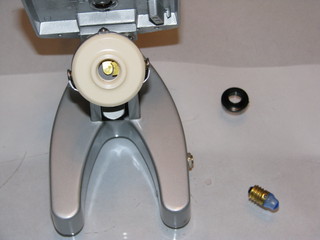
The bulb is burned-out. Not surprising, given its probable age. But I can't find an exact replacement. Apparently, the bulb uses a tungsten filament. These are no longer used because they consume a lot of energy, get very hot, and produce yellowish light (thus, the blue corrective film). No one uses these anymore. Student-grade microscopes use LEDs. (Low-end pro-models use flourescent, and better models use remote halogen light sources with positionable fiber-optic tubes.) I was hoping the transformer was also a rectifier. Unlike bulbs, LEDs aren't able to run on either AC or DC. Not a big deal, I just have to find a cheap LED that'll fit into the bulb socket, and then run it only on batteries. (In fact, I found and ordered such a bulb. It cost a few cents less than the microscope.) Now I just need some slides.
Maybe Aidan & I can look at whatever's living in goopy pond water in a few weeks . . .

The bulb is burned-out. Not surprising, given its probable age. But I can't find an exact replacement. Apparently, the bulb uses a tungsten filament. These are no longer used because they consume a lot of energy, get very hot, and produce yellowish light (thus, the blue corrective film). No one uses these anymore. Student-grade microscopes use LEDs. (Low-end pro-models use flourescent, and better models use remote halogen light sources with positionable fiber-optic tubes.) I was hoping the transformer was also a rectifier. Unlike bulbs, LEDs aren't able to run on either AC or DC. Not a big deal, I just have to find a cheap LED that'll fit into the bulb socket, and then run it only on batteries. (In fact, I found and ordered such a bulb. It cost a few cents less than the microscope.) Now I just need some slides.
Maybe Aidan & I can look at whatever's living in goopy pond water in a few weeks . . .

